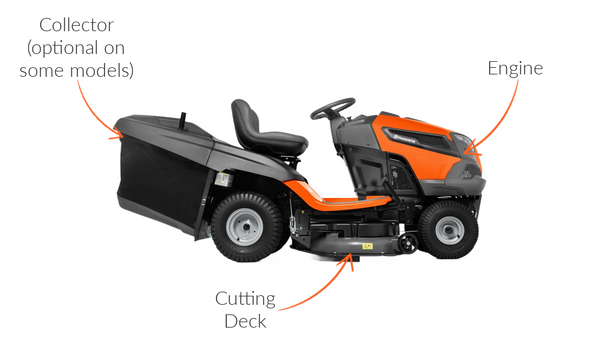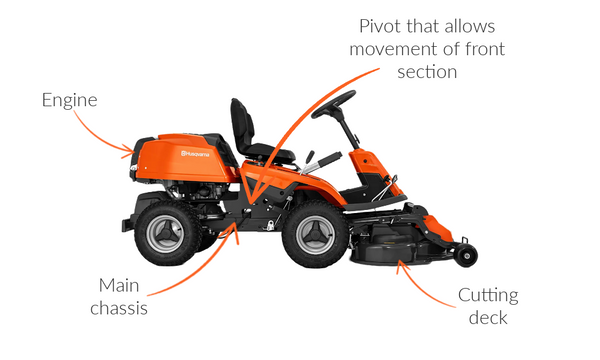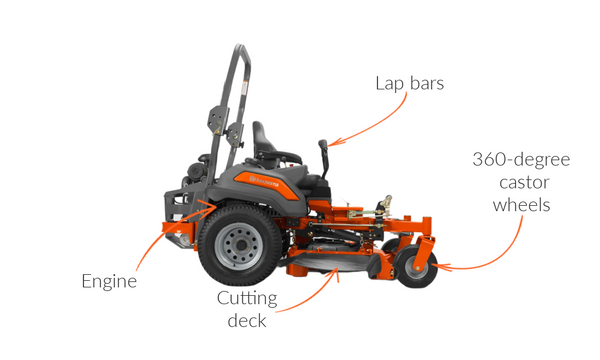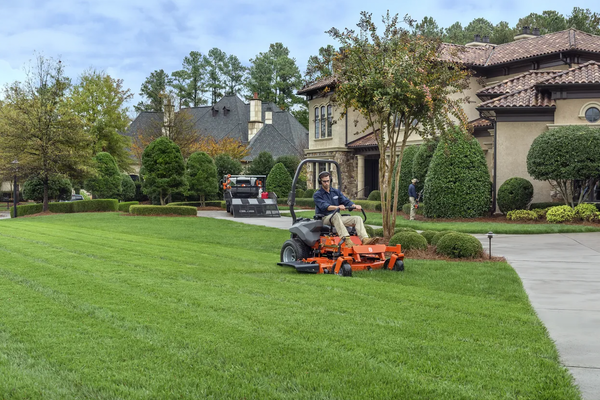If you’ve started looking for a new ride on mower for your garden, estate, groundcare business, or local authority, then you’ve probably spotted that there are a number of different types of ride on mower. If you’re not too sure which type of ride on mower is best for your particular application, then read this complete guide to the different types of ride-on mower from the team at Hughie Willett…
Ride on mower terminology
Before we proceed, we want to provide a bit of an ‘explainer’ when it comes to the terminology of ride on mowers.
You see, the various types of ride on mowers are known by different names to different people. Throw in the fact that some Americanisms have made their way over to the UK (and vice versa), and it can quickly become quite confusing.
So, here’s how we refer to the various kinds of ride on mower.
Ride on mowers can be divided into three main types:
- Mid mounted ride on mowers.
- Out front ride on mowers.
- Zero turn ride on mowers.
However, you may sometimes see these types of mowers - particularly mid mounted ride on mowers - referred to as lawn tractors, riding mowers, tractor mowers, riding lawn equipment, ride-on tractors, or garden riders.
As you can see, there are many different names for the humble ride on mower; many of which stem from the physical resemblance that many ride on mowers have to tractors.
For the sake of simplicity, here at Hughie Willett, we simply use the overarching term ‘ride on mowers’.
A note on ride on mower cutting technology
To add further potential confusion into the mix, many people name ride on mowers based on the type of cutting technology they use.
What are these technologies? They are as follows:
- Cylinder cutting systems.
- Rotary cutting systems.
- Flail systems.
As such, you may see ride on mowers referred to as ‘cylinder ride on mowers’, ‘rotary ride on mowers’, and ‘flail ride on mowers’.
You’ll find that many of these cutting technologies are more closely associated with certain types of ride on mowers than others. For example, zero turn ride on mowers almost exclusively use rotary cutting systems.
Don’t worry if all this seems confusing by the way! We’ll break down everything you need to know about each type of ride on mower later in this article.
Note - these cutting technologies are most commonly referred to as ‘cutting decks’. Cutting deck usually refers to a rotary cutting system - as it is a spinning blade enclosed within a housing which resembles a deck.
What types of ride on mowers are there?
Okay, on to the main event. Here, the team at Hughie Willett we take you through each type of ride on mower, the common questions we receive about them, and essential buying tips.
Mid mounted ride on mowers
The first thing that most people notice about mid mounted ride on mowers is that they resemble ‘mini tractors’.
They have four wheels, a seat in approximately the middle of the mower, the engine out front and (sometimes) a collector at the rear. As their name suggests, mid mounted mowers have their cutting deck located within the middle of the mower, beneath where the operator sits.

Who should buy a mid mounted ride on mower?
Mid mounted ride on lawn mowers are incredibly versatile pieces of equipment, and as such, have found use in a very wide variety of settings.
Mid mounted mowers are ideal for:
- Individual homeowners.
- Owners or managers of estates.
- Groundcare companies.
- Sports clubs.
- Local authorities.
- Farmers or others engaged in agriculture.
- Operators of commercial turf assets of all kinds.
Mid mounted mowers are ideal in scenarios where you have to mow grass on uneven terrain. For example, they are particularly suited for mowing parkland, orchards, paddocks and other similar settings.
What type of cutting technology do mid mounted ride on mowers use?
Mid mounted ride on mowers, most commonly use rotary cutting decks. These are housings which can contain one, two or three blades which are centrally anchored (think of them being similar to propellers).
The blades within the cutting deck are typically driven by a belt drive - however, hydraulically driven and direct shaft drive systems are also available.
Summary - mid mounted ride on mowers usually feature rotary cutting decks.
What type of engines do mid mounted ride on mowers have?
Your typical mid mounted mower will have a petrol or diesel engine. The configurations of the engines vary, with some mowers having three-cylinder or four-cylinder inline engines and others having two-cylinder v-twin engines. It’s also possible to buy mowers with single cylinder engines.
The power outputs of these engines can vary considerably, ranging from nine horsepower up to 26+ horsepower. In terms of displacement, mid mounted mowers can have engines with displacements as varied as 300cc all the way up to 1,100cc or higher.
In general, we’d recommend erring on the side of caution and buying a mower with slightly more power than you think you’ll need.
As an aside, we are also starting to see the emergence of ‘eco mowers’. These are electric mowers which are powered by lithium-ion batteries.
What types of transmissions do mid mounted ride on mowers have?
When it comes to selecting a mid mounted mower, you have two main transmission options; manual or hydrostatic.
Mowers with manual transmissions operate in much the same way as cars with manual gearboxes. You’ll have a clutch pedal and a gear stick.
Mowers with hydrostatic transmissions operate in a similar way to cars with automatic transmissions. Gear changes are taken care of for you whilst you operate the mower.
What sizes of mid mounted ride on mowers are there?
As we wrote in our recent buying guide to ride on mowers, there are various sizes of mid mounted mowers that you can buy.
When mower retailers talk about size, they are specifically referring to the width of the cutting deck.
This is important as it’ll determine how much grass you can cut, as well as how wide your mower will be from an accessibility viewpoint (e.g. too wide, and you won’t be able to fit through certain sized gaps, gateways etc).
What brands of mid mounted mower are there?
There are many long-established brands from across the world that manufacture high-quality mid mounted mowers. These brands include Cub Cadet, Husqvarna, Kubota, Lawnflite, Orec, and Stihl.
What are the pros and cons of mid mounted mowers?
Mid mounted mowers are reliable and versatile - but, they’re not necessarily for everyone. Below, we’ve highlighted some of the key pros and cons of mid mounted mowers.
Pros of mid mounted mowers
- Able to mow across a wide range of terrains.
- Easy to drive and operate.
- Fast ground speed and cover large amounts of ground quickly.
- Generally fairly compact and will fit on a single trailer.
Cons of mid mounted mowers
- Reduced visibility compared to other types of ride on mower.
- Not particularly good at cutting under bushes or other hard-to-reach places.
- Cutting deck can be a little more difficult to access for maintenance.

Shop mid mounted ride on lawn mowers now
Out front ride on mowers
Out front ride on mowers are very popular in the UK. They’re certainly incredibly popular amongst groundcare companies, commercial landscapers, local authorities and others.
Out front mowers have four wheels, an engine - which is mounted at the rear - a cutting deck which is situated at the front, and a traditional steering column and steering wheel.
Visually, out front mowers differ from mid mounted mowers in that some models are ‘segmented’.
By this we mean that out front mowers feature a pivot in the middle below where the operator sits; the front and rear of the mower are two independent sections which are joined together by this pivot. The operator tends to sit on this front section - which is why some people call these types of mowers ‘ride on front mowers’.
Because the cutting deck is out front and not mounted to the main chassis of the mower, it is able to ‘float’ and more accurately track the ground’s contours. This can eliminate the problem of ‘scalping’ where the blades cut too close to the ground when moving over uneven terrain.
This also means that out front mowers have very tight turning circles, making them very manoeuvrable and ideal for use in tight and confined spaces.
Out front ride on mowers have a number of other benefits aside from their manoeuvrability. For example, because their cutting deck is mounted on the front, it’s much easier to cut close up against things like trees. It’s also easier to cut under overhanging bushes and other shrubbery.

Who should buy an out front ride on mower?
Everyone! More seriously though, out front mowers are incredibly versatile and therefore ideal for a huge range of people.
They are the perfect ‘all-rounder’ offering great cutting performance, the ability to cut grass in complex areas and a fantastic finish.
This makes out front ride on lawn mowers ideal for people, businesses and organisations such as:
- Individual homeowners.
- Local authorities.
- Groundcare professionals and groundcare companies.
- Owners and/or managers of estates.
- Sports clubs.
- Farmers and others engaged in agriculture.
In particular, however, out front mowers are suited to anyone who needs to mow an area of grass that requires tight turns, and the ability to accurately mow close to edges and objects.
What type of cutting technology do out front ride on mowers use?
Almost without exception, out front mowers use rotary cutting technology. The cutting deck located at the front of the mower will normally contain between one and three rotary cutting blades.
Note - it is often possible to swap out the cutting decks on out front mowers. For example, you could swap out a rotary cutting deck that you usually use to cut grass, for a flail deck to cut overgrown areas of nettles, brambles etc.
What type of engines do out front ride on mowers use?
Out front ride on lawn mowers tend to feature either petrol or diesel engines. These engines vary from three or four-cylinder inline models through to two-cylinder v-twin or parallel twin models and even single cylinder models.
Displacement can vary, with some mowers having engines with a displacement of around 300cc and others having large displacements of 1,100cc or higher.
In recent years - like other types of mowers - we have started to observe out front mowers that are powered solely from electricity, which is drawn from an onboard battery pack.
What types of transmissions do out front ride on lawn mowers have?
Out front mowers mainly use hydrostatic transmissions - that is, the gears are selected and changed automatically on behalf of the operator.
Depending on the exact model of mower you buy, you may find that it has two pedals - one for acceleration, and one for reverse. Likewise, you can also find models with a single pedal which controls both acceleration and reverse - a lever is used to switch between the two modes.
Hydrostatic transmissions have the benefit of offering hugely variable speed control, dynamic braking and a high power-to-weight ratio. Of those benefits, variable speed control is perhaps the most advantageous. This means you won’t be restricted to preset gear speeds, and instead can mow through a wide range of speeds.
So, an out front mower with a hydrostatic transmission is unlikely to struggle over difficult terrain and will offer seamlessly smooth gear changes - ideal when you want to achieve an accurate, neat cut.
What sizes of out front mower can you buy?
As with mid mounted mowers, when we talk about the width of out front mowers, we are referring specifically to the width of the cutting deck.
Cutting deck size can vary considerably from mower to mower. Here at Hughie Willett, we sell mowers with cutting decks ranging from 30-inches, all the way up to 72-inches.
The width of the cutting deck will determine how much grass you can cut in a single ‘pass’, but will also determine the size of the gaps and entrances that your mower can pass through - so it’s important to give this some serious thought when selecting your mower.
What brands of out front mowers are there?
Like mid mounted mowers, there are a range of companies that design and manufacture out front ride on mowers.
Here at Hughie Willett we sell out front mowers from the very best brands such as Cub Cadet, Kubota, and Husqvarna.
What are the pros and cons of out front ride on lawn mowers?
Is an out front ride on mower right for you and the purposes for which you’ll be using it? Check out some of the pros and cons of this type of mower below.
Pros of out front ride on mowers
- Maximum visibility, allowing for more accurate cuts.
- Smooth cutting due to the air pressure that is generated by the position of the cutting deck.
- Perfect for cutting awkward and hard to reach areas.
- The cutting deck can often be easily swapped for other attachments - providing more flexibility.
Cons of out front ride on mowers
- Driving these mowers can take a bit more getting used to than mid mounted mowers.
- Out front ride on lawn motors often don’t feature grass collectors.

Shop out front ride on lawn mowers now
Zero turn ride on mowers
The third most common (and popular!) type of ride on mowers are zero turn ride on lawn mowers.
Zero turn mowers are - as their name suggests - able to turn completely within their own footprint. With a zero turning circle, they offer the ultimate in manoeuvrability.
Zero turn mowers are also - arguably - the most visually distinct of all the ride on mowers. In order to facilitate their zero turning circle, zero turn mowers feature two standard wheels at the rear, and two castor wheels at the front.
The engine on the ride on mower typically sits atop the rear axle (or ever so slightly in front of it). The operator is usually sat over the engine or just forward of it.
In terms of steering and operation, zero turn mowers don’t always have traditional steering columns and steering wheels. Instead, they feature two hand levers (sometimes called ‘lap bars’) which are used to allow the mower’s very sharp turns. In addition, on many zero turn mowers, acceleration and reverse are also controlled by the lap bars.
The cutting deck on a zero turn mower is usually located within the middle of the mower - i.e. between the front and rear sets of wheels and beneath the operator’s seat.

Who should buy a zero turn mower?
Zero turn mowers are ideal for a wide range of applications. This is aided by the fact that zero turn mowers are particularly fast - not just at turning, but in a straight line too.
Their ability to mow with precision also makes them a favourite of those people/organisations/businesses that want to achieve a very smart finish to their lawns.
Common buyers of zero turn mowers include:
- Local authorities.
- The owners and/or managers of estates.
- Groundcare professionals and groundcare businesses.
- Sports clubs, schools, and anywhere else that has to manage large tracts of grass.
- Individual homeowners.
What type of cutting technology do zero turn ride on mowers use?
On the majority of zero turn mowers, you’ll find that their cutting decks utilise rotary cutting technology. This is because rotary cutting decks provide great all-round cutting performance.
Whether you’re cutting a standard flat lawn, or having to tackle rutted grass between trees in an orchard, a rotary cutting deck will do the job with aplomb.
What types of engines do zero turn mowers use?
Like the other types of mowers we’ve talked about in this article, zero turn mowers are available with a range of engine types - from single cylinder ‘thumpers’, to torque-y v-twins, through to silky smooth inline three or four-cylinder engines.
Displacement varies considerably, too. You can find smaller zero turn mowers with engines that only have a displacement of around 300cc through to mowers with displacements of 1,100cc or more.
As we enter the era of electrification, we expect to see new electric zero turn models hitting the market that draw their power from an onboard battery pack.
What types of transmissions do zero turn mowers have?
Zero turn mowers generally almost always have automatic, hydrostatic transmissions. This is mainly because it would be difficult to execute the tight turns of which these mowers are capable whilst also having to manage the changing of gears.
In other words, with a hydrostatic transmission in place, you can concentrate on turning and steering your zero turn mower and achieving the perfect cut.
What sizes of zero turn mower are there?
As with other types of ride on mower, you want to be looking at the width of the cutting deck. This will determine both where you can take your mower, and how much grass you can cut during each pass.
At Hughie Willett, we sell zero turn mowers with cutting decks that range from 42-inches up to 72-inches.
What brands of zero turn mowers are there?
As you’d expect, there are a range of American, Asian and European brands designing and manufacturing zero turn mowers.
The brands that we view as offering the best quality and value for money when it comes to zero turn mowers are Cub Cadet, Husqvarna and Kubota.
What are the pros and cons of zero turn ride on lawn mowers?
Have you got your sights set on a zero turn mower? Then ensure you’ve read these pros and cons first.
The pros of zero turn ride on mowers
- The ultimate in manoeuvrability, with tight turning circles.
- Fast - zero turn mowers generally have a high operating speed.
- Maximum visibility - it’s very easy to see where you have, and haven’t, cut.
The cons of zero turn ride on mowers
- They can be challenging to learn to drive at first.

Shop zero turn ride on lawn mowers now
Where to buy ride on mowers
We hope you’ve found our guide to the different types of ride on mowers both useful and interesting.
If it’s helped you to decide which type of ride on mower is right for you, and you’re ready to buy, then buy one from Hughie Willett!
We possess extensive knowledge about mowers in general and can advise you on the right mower to meet your requirements. We carry a wide range of stock and are also able to service and maintain your mower once you’ve bought it.
If you’d like to speak to a member of our friendly, expert team, you can call us on 0121 308 1262 or send us a message using our contact form.
